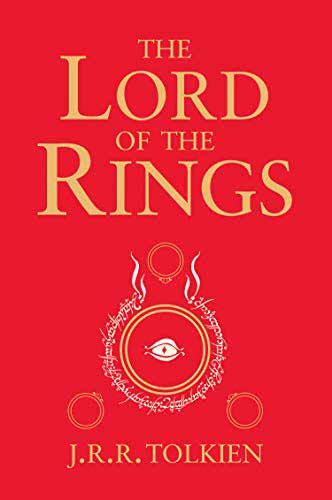Lord of the ring
The Lord of the Rings is the paragon of fantasy literature. Written in 1937 by professor of linguistics J.R.R. Tolkien, it is a high-fantasy epic that is one of the most recognizable works of fantasy in the world–something that the recent Academy Award-winning film series did much to cement in popular culture.
The Lord of the Rings is the paragon of fantasy literature. Written in 1937 by professor of linguistics J.R.R. Tolkien, it is a high-fantasy epic that is one of the most recognizable works of fantasy in the world–something that the recent Academy Award-winning film series did much to cement in popular culture.
As I’ve mentioned, I am a huge fan of both fantasy in general and the films specifically. My first read through the series occurred during my high school years and, I’m sad to say, was not very enjoyable. I saw the movies before reading the series and I think this did much to set my expectations up for an entirely different type of story-telling. In the last few months my husband and I played through Lego Lord of the Rings and it got me to thinking that maybe now, after getting both a bachelor’s and master’s degree in English literature, I’d be ready to read through the series again with an open mind.
I’m so glad I did. My journey along with Frodo was excellent on this go around. There’s simply so much to enjoy about these books.
First, as many have already said, the richness of the world Tolkien created is just stunning. Much of the book is devoted to telling the history of the places Frodo and his companions journey through and the people they encounter. I loved the way the story of Frodo and the ring fits into a larger narrative about the Numenorians, the long struggle of the Maiar against Melkor (and his servant, Sauron), and the rise of men alongside the slow deterioration of the older beings in Middle Earth like elves and ents. Everything in Middle Earth has a story. Everything matters. Nothing feels as though it was just thrown in Frodo’s path errantly by Tolkien to further the plot.
At times during reading I found myself just as drawn in by Tolkein’s descriptions of a place or of some particular race as I was by the actual plot. Nowhere was this more the case than during his descriptions of hobbits in the Fellowship of the Ring. Tolkien’s love of hobbits and hobbit culture is very clear–they seem almost to be his favorite race in Middle Earth. I felt fully immersed in Hobbiton for the Long Expected Party and I could clearly see in my mind’s eye the landscape of the Shire in autumn as Frodo, Sam, and Pippin began their trek away from Bag End. In general, I enjoyed most the parts of the story centered on the Hobbits.
Second, I found that I enjoyed the use of magic and the supernatural in these books more than I have in almost any other. I dislike when magic is too straightforward. Despite being a fan of the Harry Potter series, it’s a good example of magic that’s just too overly simplified. Just say a latin word and wave a wand and anything you want might happen. I like that in LOTR magic is a bit mysterious. Certain characters obviously can use it–Tom Bombadil, Gandalf, Aragorn, Elrond, even Sauron–but their use of it takes more from them than a few words. Gandalf and Bombadil describe themselves as being drained after performing large magical acts. Gandalf’s rise from the “dead” is plausible but enjoyably mysterious to the reader. Sauron’s link to the ring is similarly understandable yet tantalizingly strange.
Finally, I found certain characters or relationships to be pleasing on a very deep level. Everything about Treebeard and the Ents in general is simply wonderful. I don’t think any author since Tolkien has managed to think up a better fictional race or character. Stumbling upon Treebeard with Merry and Pippin was one of my favorite moments in the book and, I think, one of the places in which the movie truly got it wrong. They did an injustice to Treebeard by changing the story to make him a coward–an old fool who doesn’t know his own forest well enough to know it needs his protection until Merry and Pippin lead him to Isengard.
Speaking of Merry and Pippin, their friendship was another highlight. The mental image I have of the two feasting in the wreck of Isengard, taunting Gimli with food and pipe weed is as clear as a picture. I also quite enjoyed the friendship between Gimli and Legolas. I love that the two journey together after the destruction of the ring through the caverns at Helm’s Deep and Fanghorn forest. And, obviously, Eowyn sticks out as a lovely, strong character. She is particularly enjoyable to me because I know that Tolkien wrote her–fierce and unyielding on the battlefield and in love–during a time when feminism wasn’t nearly as popular an idea as it is today. Her fight with the witch king of Angmar is the highlight of the Battle of Pelennor Fields.
But it’s not just the highlight because Eowyn is such a bad ass. It’s also the highlight because it’s one of the few moments in that battle that we get to see a zoomed in look at what is happening. If at any point these books fail it’s in describing large battle scenes with real depth and color. After seeing the movies, it’s a bit shocking to read through the battle of Helm’s Deep and the Battle of Pelennor Fields. Everything happens so quickly and in such overview. We don’t see grisly descriptions of orc decapitations or in-depth looks at how many siege towers there were and how they functioned. I don’t feel amiss in saying that the larger battles weren’t of much interest to Tolkien in the grand scheme of things. Even the moment of the destruction of the ring passed so quickly I felt amazed. Just a few paragraphs describe the destruction of Morder, which feels amazing after reading pages of description of things that seems less important to the plot, like the landscape or the history of cities that are related to the main story in only a cursory way.
In general, I found the books becoming less enjoyable to read as they neared the climax of the plot. The scope of the plot gets wider, encompassing more and more characters, and individual detail often falls into obscurity. As a character, Aragorn is completely lost to me after the battle of Helm’s Deep. Only the hobbits remain in clear focus as we get in-depth views of Merry’s hurried ride down to Minas Tirith and Pippin’s few days as part of the watch of Gondor.
I think, though, that rather than being a failing of the book this may be just what Tolkien intended. After all, this is a story about many things, but it’s mainly about hobbits. We start in the Shire and we don’t end until we’re back in the Shire and all the four hobbits stories are resolved. This is why, despite so many non-readers complaints, I appreciated that the films followed the story all the way to its end in the Gray Havens and back to Hobbiton with Sam.
Speaking of the movies, I’d like to end with a note on how surprised I was to find such large differences between the movies and the books. I had been maintaining for years that the films are the most faithful book-to-movie adaptation ever made. And though I might still make this claim, I know now how thin, at times, it is. The most notable differences to me included the fact that years passed between Bilbo’s departure and Frodo’s, the fact that farmer Maggot was a huge aid to the hobbits, the complete removal of Bombadil along with the Barrow Downs and the Old Forest, the replacement of Glorfindel with Arwen, pretty much anything to do with Arwen’s story, the painting of Lothlorien as a scary place when in the books it’s the most heavenly place any of them has ever seen, Eomer’s banishment, Treebeard deciding not to fight Isengard, the complete removal of the Huorns from the battle of Helm’s Deep, Faramir’s attempt to take the ring and him taking the hobbits to Osgiliath, and the removal of the scouring of the Shire. Yet despite these significant changes, the movies still do a great job of representing the books. The dialogue in the films is often taken word-for-word from the books–even if those words came from a different character’s mouth. Overall, I think the tone and sincerity of the movie matches what you find in the books. I wonder what Tolkien would have thought of them.
The books are nothing short of a masterpiece. I’ve highlighted here just a few of the things I most enjoyed about them, but I’m sure subsequent rereads will produce even more thoughts. For now, I’ve moved on to reading The Silmarillion.
Have you read The Lord of the Rings? If so, I’d love to hear your thoughts in the comments.
This article has been taken from Here.





